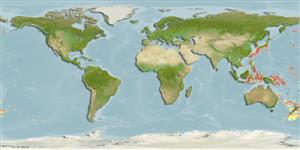>
Gadiformes (Cods) >
Macrouridae (Grenadiers or rattails)
Etymology: Ventrifossa: Latin, venter, ventris = belly + Latin, fosa = pit (Ref. 45335).
Environment: milieu / climate zone / depth range / distribution range
Écologie
marin bathydémersal; profondeur 280 - 1211 m (Ref. 95664). Deep-water
Western Pacific: Okinawa Trough, Taiwan and the South China Sea off Luzon, Philippines.
Taille / Poids / Âge
Maturity: Lm ? range ? - ? cm
Max length : 25.0 cm TL mâle / non sexé; (Ref. 54421)
Description synthétique
Morphologie | Morphométrie
Mouth inferior with long barbel, mandibular teeth in very narrow band, and slender dense spinules arranged in convergent rows or quincunx order on scales. A few or no spineless scales behind 1st dorsal. Scale sacs on upper 1/2 of body and along base of anal fin with narrow, dark brown posterior margin. Ventral luminous organ comparatively large, situated between pelvic bases and connected with periproct by narrow naked groove. Snout more or less pointed. Mouth moderately large, upper jaw extending to a vertical from posterior rim of orbit. Upper lip with rather broad dark margin. Vent much nearer to pelvic vase than to anal fin. First dorsal fin uniformly dark (Ref. 54421).
Life cycle and mating behavior
Maturité | Reproduction | Frai | Œufs | Fécondité | Larves
Cohen, D.M., T. Inada, T. Iwamoto and N. Scialabba, 1990. FAO species catalogue. Vol. 10. Gadiform fishes of the world (Order Gadiformes). An annotated and illustrated catalogue of cods, hakes, grenadiers and other gadiform fishes known to date. FAO Fish. Synop. 125(10). Rome: FAO. 442 p. (Ref. 1371)
Statut dans la liste rouge de l'IUCN (Ref. 130435)
Menace pour l'homme
Harmless
Utilisations par l'homme
Plus d'informations
Noms communsSynonymesMétabolismePrédateursÉcotoxicologieReproductionMaturitéFraiRassemblement de ponteFéconditéŒufsDéveloppement de l'œuf
Taille/ÂgeCroissanceLongueur-poidsLongueur-longueurFréquences de longueursMorphométrieMorphologieLarvesDynamique des populations larvairesRecrutementAbondanceBRUVS
RéférencesAquacultureProfil d'aquacultureSouchesGénétiqueElectrophoresesHéritabilitéPathologiesTraitementNutrientsMass conversion
CollaborateursImagesStamps, Coins Misc.SonsCiguateraVitesseType de nageSurface branchialeOtolithesCerveauxVision
Outils
Articles particuliers
Télécharger en XML
Sources Internet
Estimates based on models
Preferred temperature (Ref.
123201): 6 - 10.6, mean 7.8 °C (based on 322 cells).
Phylogenetic diversity index (Ref.
82804): PD
50 = 0.5000 [Uniqueness, from 0.5 = low to 2.0 = high].
Bayesian length-weight: a=0.00219 (0.00111 - 0.00431), b=3.20 (3.03 - 3.37), in cm total length, based on LWR estimates for this (Sub)family-body shape (Ref.
93245).
Niveau trophique (Ref.
69278): 3.7 ±0.5 se; based on size and trophs of closest relatives
Résilience (Ref.
120179): Milieu, temps minimum de doublement de population : 1,4 à 4,4 années (Preliminary K or Fecundity.).
Fishing Vulnerability (Ref.
59153): Low vulnerability (15 of 100).
